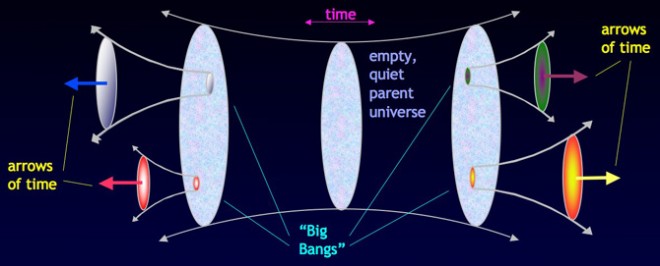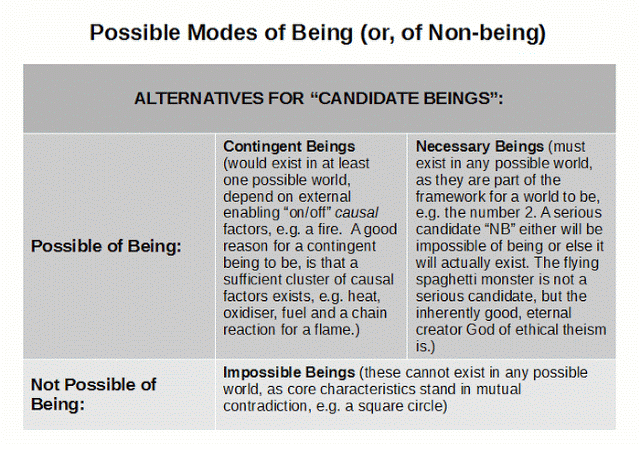The exploration in-the-wild on Heidegger’s pivotal question is turning out to be quite fruitful. Here, we see BBC swing and miss, leading to dancing stumps.
Dancing stumps:

Video, with one of the greats at bat:

First, context, we are discussing here popularised forms of the idea that “nothing” has been defined by physicists to denote in effect a sub-universe that gives rise to quantum fluctuations and thus expanding sub-universes. Let’s clip from the parent thread LFP 24:
[KF, LFP 24, 41:] Let us continue our “in-the-wild” exploration, here a Robert Adler BBC article (as representing what we might find in high-prestige media):
[BBC:] >>Why is there something rather than nothing?
By Robert Adler
6 November 2014
People have wrestled with the mystery of why the universe exists for thousands of years. Pretty much every ancient culture came up with its own creation story – most of them leaving the matter in the hands of the gods – and philosophers have written reams on the subject. But science has had little to say about this ultimate question.However, in recent years a few physicists and cosmologists have started to tackle it. They point out that we now have an understanding of the history of the universe, and of the physical laws that describe how it works. That information, they say, should give us a clue about how and why the cosmos exists.
Their admittedly controversial answer is that the entire universe, from the fireball of the Big Bang to the star-studded cosmos we now inhabit, popped into existence from nothing at all. It had to happen, they say, because “nothing” is inherently unstable.
This idea may sound bizarre, or just another fanciful creation story. But the physicists argue that it follows naturally from science’s two most powerful and successful theories: quantum mechanics and general relativity . . . .
Quantum mechanics tells us that there is no such thing as empty space. Even the most perfect vacuum is actually filled by a roiling cloud of particles and antiparticles, which flare into existence and almost instantaneously fade back into nothingness.These so-called virtual particles don’t last long enough to be observed directly, but we know they exist by their effects . . . . [W]hen quantum theory is applied to space [–> note, we are now dealing with cosmology informed by extensions of Einstein’s General Theory of Relativity over the past century] at the smallest possible scale, space itself becomes unstable. Rather than remaining perfectly smooth and continuous, space and time destabilize, churning and frothing into a foam of space-time bubbles.
In other words, little bubbles of space and time can form spontaneously. “If space and time are quantized, they can fluctuate,” says Lawrence Krauss at Arizona State University in Tempe. “So you can create virtual space-times just as you can create virtual particles.”
What’s more, if it’s possible for these bubbles to form, you can guarantee that they will. “In quantum physics, if something is not forbidden, it necessarily happens with some non-zero probability,” says Alexander Vilenkin of Tufts University in Boston, Massachusetts . . . . So it’s not just particles and antiparticles that can snap in and out of nothingness: bubbles of space-time can do the same. Still, it seems like a big leap from an infinitesimal space-time bubble to a massive universe that hosts 100 billion galaxies. Surely, even if a bubble formed, it would be doomed to disappear again in the blink of an eye?
Actually, it is possible for the bubble to survive. But for that we need another trick: cosmic inflation . . . . a fraction of a second after the Big Bang, the quantum-sized bubble of space expanded stupendously fast. In an incredibly brief moment, it went from being smaller than the nucleus of an atom to the size of a grain of sand. When the expansion finally slowed, the force field that had powered it was transformed into the matter and energy that fill the universe today. Guth calls inflation “the ultimate free lunch”.>>
[KF:] This is of course an expanded form of Dr Dawkins’ assertions in the OP above, where he made such heavy weather over the difference between something and a genuine no-thing. Thus, it falls victim to precisely the same inadvertent bait-switch fallacy that we already saw. In effect, it proposes a quasi-physical, speculative sub-universe that provides a space-time, energy-rich context for inflationary bubbles to form and toss up sub-cosmi such as ours, allegedly. With, of course, the sub-verse lurking as the implicitly claimed, brute fact necessary being world-root.
Never mind, heat death, traversal of the transfinite past in finite stage steps, the overwhelmingly more likely event of a deluded Boltzmann brain or even a comm coll term assignment to run a world simulation (and play at being god) etc as issues. And of course, don’t ponder the significance of fine tuning of our cosmos fitting it for C-chem aqueous medium life or how we get beyond dynamic-stochastic computation on substrates to genuine rational freedom and moral government of our intellectual life through inescapable duties to truth, to right reason, to prudence, to sound conscience, to neighbourliness, to justice, etc.
In short, in this “tell it to grandma” form, we are right back at the challenge: which candidate to be the necessary being world-root is the best explanation. Philosophy done while wearing a lab coat is still philosophy, and a relativity- and quantum- influenced space-time domain prone to instabilities and formation of inflation-prone bubbles — despite erroneous, misleading labels — is not a genuine no-thing.
So, absent an infinite reservoir of energy, absent a credible means to traverse a transfinite causally successive past in finite-duration stages (“years” for convenience), absent a good explanation for a fine-tuned world at so deeply isolated an operating point as the observed cosmos is, and absent a good explanation for mind under moral government, we should not be overly disturbed by such philosophising while wearing a lab coat and filling chalkboards with quantum and relativity calculations.
This inadvertently underscores the significance of the issue and opens up where it points. (It also brings out how ID-linked questions are routinely handled in the subtext without the courtesy of a serious mention or allusion. Yes, design theory issues are also highly important, but are deemed beyond the pale of “respectable” discussion, save to denigrate and dismiss. Welcome to the brave new world of C21 media.)
Earlier in the discussion, an occasional objector had suggested:
28 Pater Kimbridge July 24, 2019 at 9:59 am
“Why is there something rather than nothing?”
That’s the dumbest question humans have asked.
It presupposes that “nothing” is the default state, and that “something” requires explanation.“Nothing” is actually the harder state to achieve. If you don’t believe me, go ahead and try to achieve it.
To this, I responded [KF, 30:] >>actually, the point is that given a going concern world with rational, responsible, morally governed creatures in it, there is a very plausible assumption, the weak form PSR:
[PSR, weak (investigatory) form:] Of any particular thing A that is
[. . . or (ii) is possible, or even (iii) is impossible],
we may ask, why it is
[. . . or (ii’) why it is possible, or (iii’) why it is impossible],
and we may expect — or at least hope — to find a reasonable answer.
That’s one jaw of our pincers.
The second, being the logic of being that fits well with it (cf. OP [–> all of that stuff about possible worlds then impossible vs possible beings, with some of the latter contingent and some necessary] ).

We can then get a solid grip on things.
Here, the subject of inquiry is one that Heidegger saw as big and insightful — and note this is the title and lead of the OP:
To philosophize is to ask “Why are there essents rather than nothing?” Really to ask this question signifies: a daring attempt to fathom this unfathomable question by disclosing what it summons us to ask, to push our questioning to the very end. Where such an attempt occurs there is philosophy. [ M. Heidegger, An Introduction to Metaphysics, Yale University Press, New Haven and London (1959), pp. 7-8.]
Whose report do you think we should believe, yours or one of the greats, Heidegger?
On exploring, first we see that nothing is no-thing, non-being. Were there ever utter nothing, we would have no reality whatsoever, so we can now contemplate an alternative to what we experience. That is already a very powerful result of pure reflection on being.
But then also we see, non-being can have no causal capabilities.
So, if there were ever utter non-being, such would always be the case. That is, that a world is, implies that something has always been there, which we can term a root of reality.
Another very powerful result.
Further to this, that root taken as a whole is credibly an independent or necessary being. NB’s, being present as part of the framework for any possible or actual world, and being independent of external enabling causal factors, A simple case is the number 2.
Another very powerful result, we see that there is a root for any possible or actual world with causal capacity to account for it.
Going on, our world has in it morally governed, rational (not merely computational) creatures, us. That further constrains the root of reality. We are credibly requiring an inherently good and utterly wise NB as root of reality, to account for moral government as that is where the IS-OUGHT gap can be bridged (hence, BTW, the sort of resistance above). Such starts with government of our rationality through duties to truth, right reason, prudence, justice etc. Indeed, these govern our exchanges in this thread.
So, another powerful result, one that shifts the balance decisively against those who would suggest that moral government is delusional, and/or that it does not trace to a being that fills the required bill.
Not bad for a stupid or dumb question.>>
Looks like the philosophical dumb oxen are still filling the world with their bellowing. END